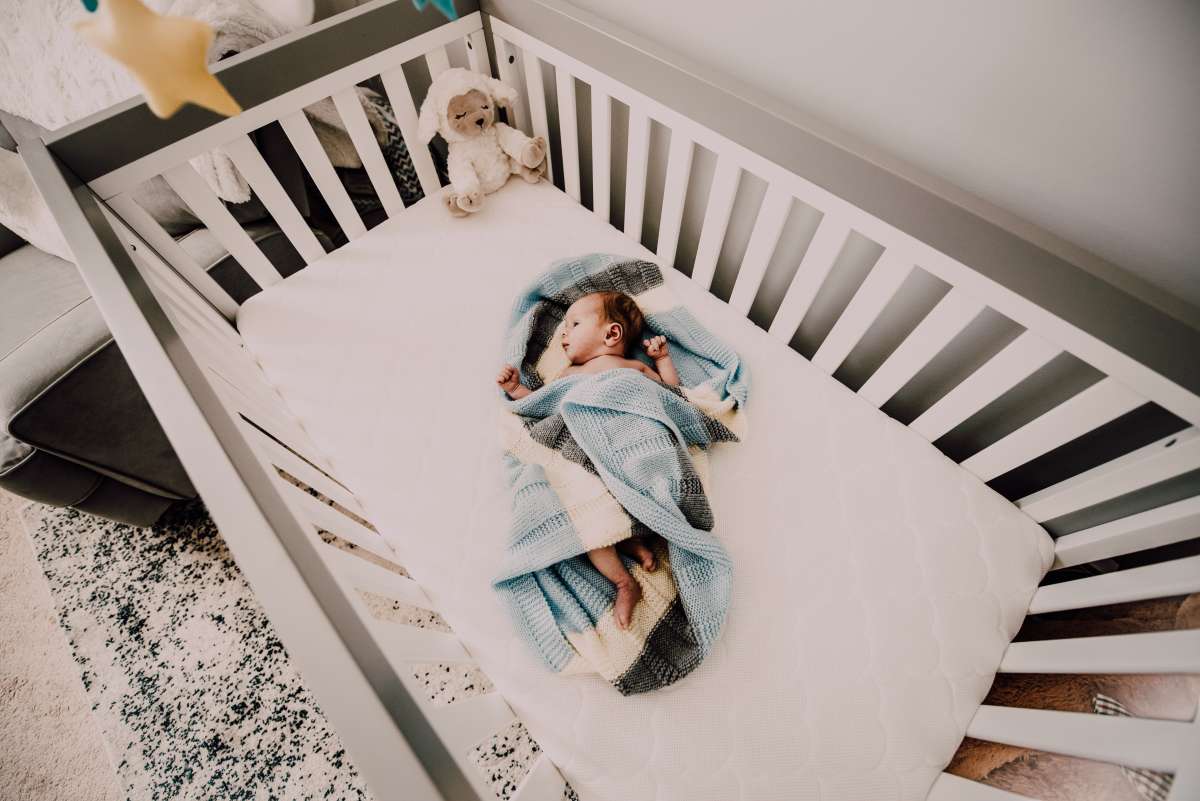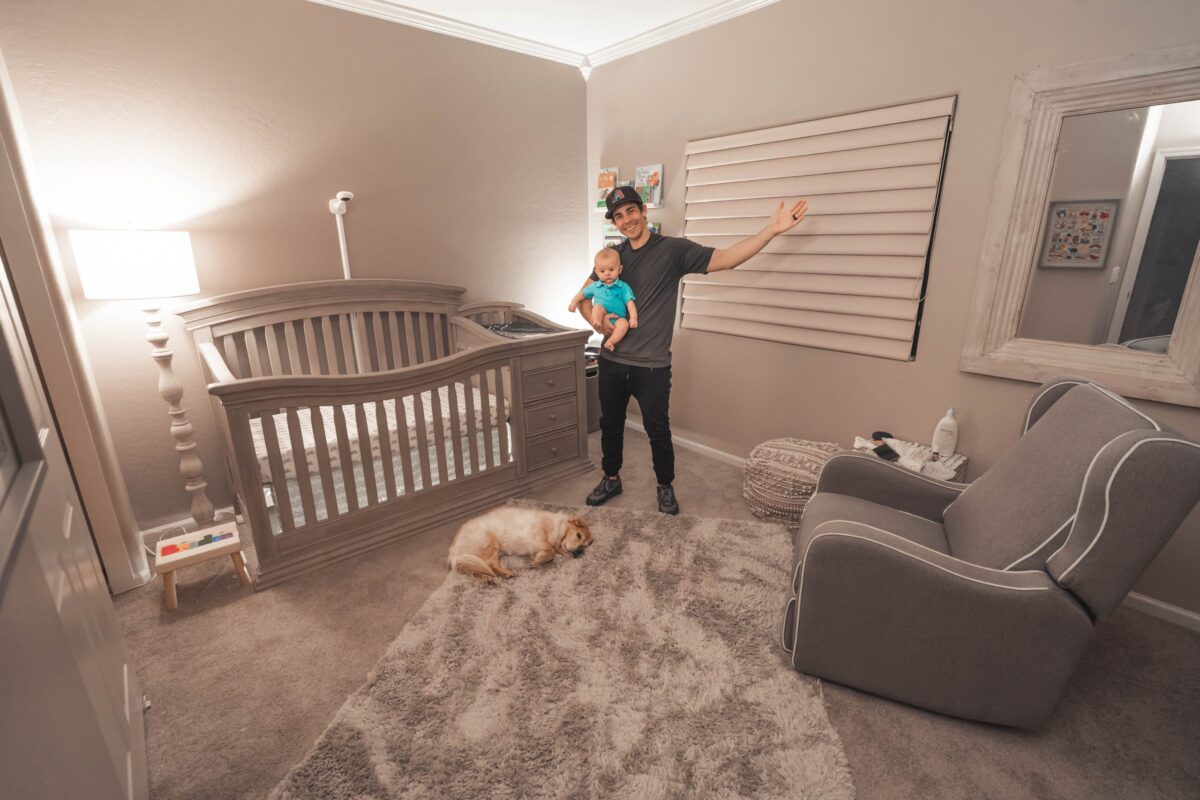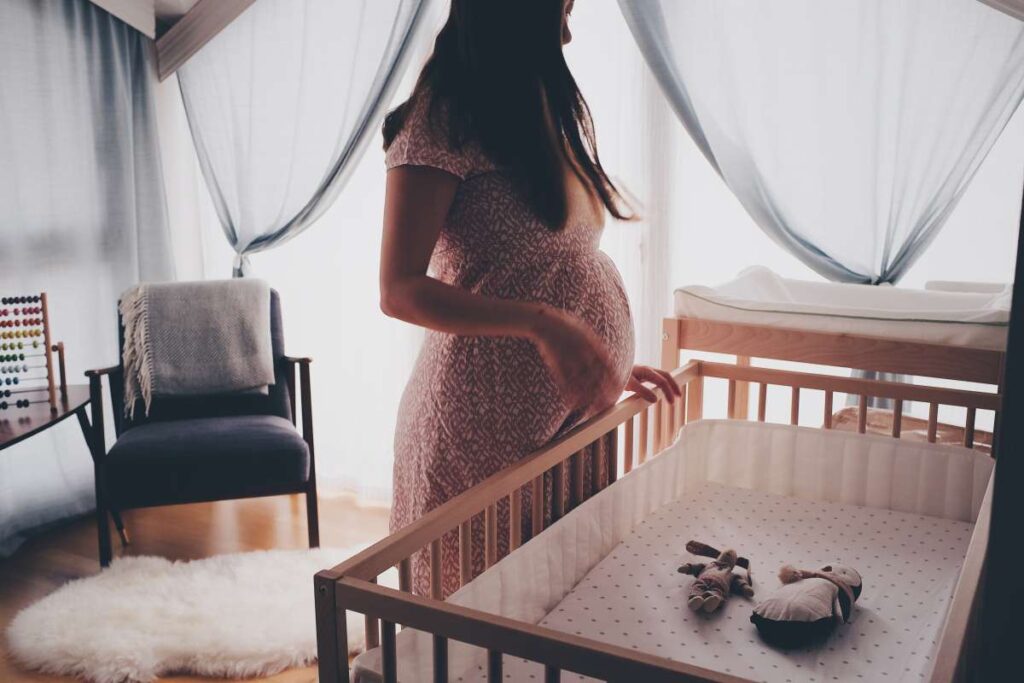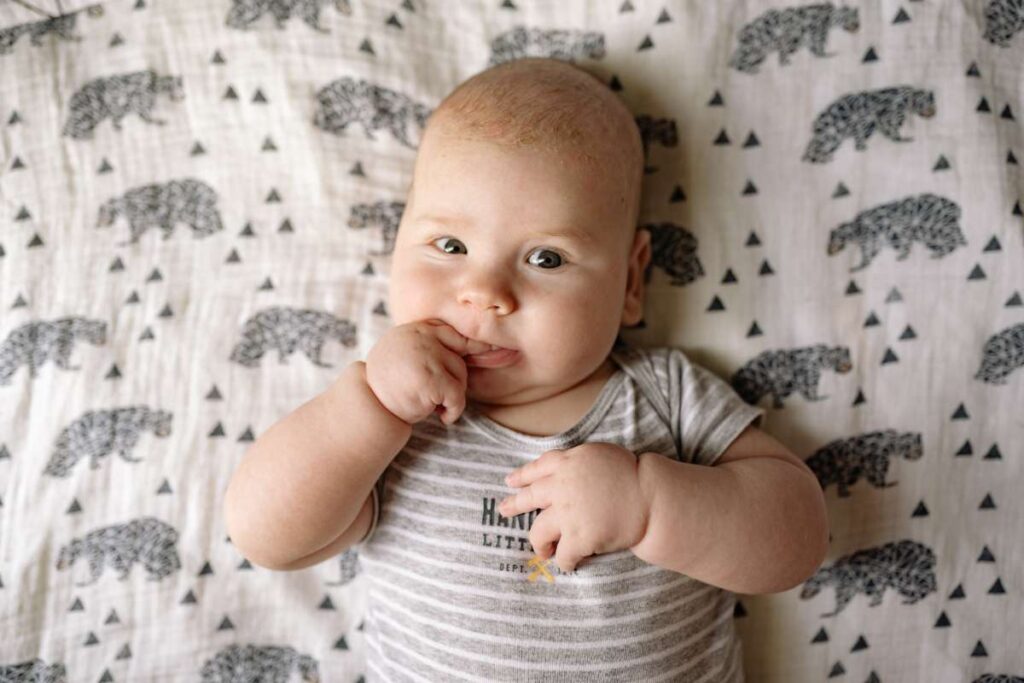Silence is golden—unless you have a toddler, in which case it probably means they’re up to (or on) something (like the top of the bookshelf).
In these moments, it helps to know you’ve done everything you can to stay one step ahead of your fearless adventurer. As any experienced parent will tell you, baby-proofing is essential—especially in the nursery where your little one will rack up more than a few hours of unsupervised time. Our exclusive range of baby nursery products will help create the perfect baby nursery for your baby.
Crib Regulations
Before laying your little one down in any crib (new or used), you’ll want to ensure that it meets the following safety regulations:
Corner posts.
Corner posts over 1/16 of an inch high are a no-no unless they exceed 16 inches. Your child’s clothing could become caught on posts, resulting in strangulation.
Fixed Sides.
Cribs must have fixed sides. Drop-side cribs pose a severe threat to infants, many of whom have been injured or even killed due to hardware malfunctions common to the crib’s design.
Mattresses.
The crib mattress must be firm and fit the crib properly. There should be no more than two finger’s width of space between the side of the bed and the crib frame. Any larger and your baby may become entrapped between the two, resulting in injury or suffocation.
Slats.
Crib slats should be no further than 2 3/8 inches apart to prevent your baby from trapping his head or limbs between the bars.
Crib Safety Tips

Once you are sure your crib is up to current standards, follow the American Academy of Pediatrics (AAP) crib safety tips.
- Avoid sleep positioners and similar products —even if they claim to reduce the risk of SIDS. No actual evidence exists to support these claims, and several infants have suffocated as a result of their use.2
- Blankets, pillows, and bumpers of any kind pose a risk of suffocation and or entrapment and should never be used in a crib. Remove all soft toys and bedding from your baby’s crib except a fitted sheet and a thin, water-resistant mattress cover.
- Do not hang anything over the crib or in the nursery using a length of string that’s longer than seven inches. Longer lengths of rope pose a risk of strangulation. Mobiles should also meet the seven-inch rule and should be removed once your little one can push up onto his or her hands and knees.
- Do not place a crib next to a heater or in an area that experiences direct sunlight. This helps prevent your child from overheating (a known risk factor associated with SIDS).
- Inspect your child’s crib regularly, ensuring that the mattress frame is secure and that there is no missing, loose, or damaged hardware.
- Keep all cords at least 3 feet from the crib—especially the baby monitor cord—as they are a strangulation risk.
- Never hang heavy items, like mirrors and large frames, directly over your baby’s crib. They could fall and injure your child.
- Position the crib away from windows and other furniture that could pose a hazard should your child attempt to climb out of the crib.
- Remember to adjust your crib’s mattress level as necessary. For safety’s sake, lower the mattress to a group as soon as your child can sit upright and again once your little one begins to stand. If your child reaches 35 inches in height and has not yet transitioned to a bed, it’s time to make the change.
Furniture Risks
Anchor furniture such as dressers and bookshelves to the walls with braces.
It is not just tall furniture that needs to be anchored—any furniture that has drawers or shelves needs to be anchored as a child can climb it or tip it over on themselves. If there is a TV in the child’s room, it also needs to be anchored.
Avoid furniture with glass doors. Prevent your toddler from climbing open dresser drawers by securing them with childproof locks.
Rocking chairs and even modern gliders can also cause injury. To protect little toes and fingers, choose a glider, preferably one with a stop-lock mechanism that prevents the chair from sliding when not in use, and be sure that all gears are encased and out of reach.
Anchor furniture and televisions to prevent severe injuries from tip-overs. Even heavy pieces of furniture can become unstable if the doors or drawers are opened, pulled or climbed on.
Anchoring or tethering devices must be designed to support the unit’s weight and must be securely fastened with screws into wall studs.
Keep all furniture away from windows. This ensures that cribs are away from window coverings and helps prevent toddlers from climbing near windows.
Toy chests can be very dangerous and deserve special consideration.
Old-fashioned toy chests that do not feature spring-loaded hinges can slam shut, crushing your child’s hand or head.
If your chest doesn’t have a spring-loaded hinge, consider replacing it or removing the lid altogether.
You’ll also want to make sure the chest is well ventilated and can be opened from the inside to prevent your toddler from becoming trapped and possibly suffocating.
Doors and Windows
Blinds with long, exposed cords can pose a strangulation hazard for small children. Before leaving your toddler unsupervised in their room, ensure that all lines are safely out of reach.
If you choose to install blinds, be sure to cut off the pull cords or pick up and install a safety device designed to control cord access.
Cordless window treatments and blinds are best. Blinds with cords are a strangulation hazard. Go cordless!
Install window guards or window stops on windows. A window stop prevents the window from opening more than a few inches (but has a release mechanism for emergency exit).
Even if windows are above a child’s typical reach, a child might move a chair or toy to reach the window. Note: screens will not protect a child from falls and are meant to keep bugs outside.
Curtain hardware that is improperly installed or insufficiently fixed can fall on your child, especially if he or she pulls on the curtain panels.
To prevent accidents, ensure that all curtain hardware is fixed directly to a wall stud or secured with the appropriate drywall anchors. Not much of a handyman? Hire one.
Do not purchase curtains that feature beaded decorations, decorative cording, and other such embellishments. These items may become loose and could be pulled off by a curious toddler, posing a choking hazard.
Keep furniture away from windows, reducing the temptation to climb up and preventing falls.
Little fingers are easily pinched in bi-fold doors. Keep the kiddos out of the closets and prevent accidents by installing door guards, sliding over the divide preventing the hinges from opening.
Never depend on screens to keep children from falling out of windows. Unlike window guards, which can be purchased at any hardware store, screens are not designed to prevent falls.
You can also install window stops, which prevent windows from opening more than a few inches.
Prevent late-night walkabouts by installing a baby gate or device that prevents toddlers from operating a door handle.
Window Coverings & Cords
Make sure curtains, drapes & blinds are well secured to the frame of the window. If your child can reach them, they can hold on to their dead weight and destroy them quickly.
Tie or throw your curtains up over the rod for a few months. If you have blinds with a cord hanging down, get a cord winder or a hook to wrap it around high up on the wall.
Window Locks
These are especially handy if your kiddos are up on the second floor; locking the windows prevents them from throwing things out the window or climbing and falling.
Door Handles
If there is a closet or room door that you don’t wish for your little one to open, grab a childproof handle cover. Kids find a great time to experiment with new skills is in their room in the middle of the night.
Dressers & Bookshelves
Use furniture straps to secure all furniture to the wall. Kiddos are like monkeys, and they will find a way to climb up. You don’t want them to pull anything down on themselves!
Bed Frames
If you have an old school metal bed frame that sits under the bed, then you have those pesky little legs that make you want to die when you stub your toe on them.
Grab a pool noodle and cut it down to size. Make a slit up one side and wrap it around the leg. It’s usually a good idea to duct tape it closed so your little one doesn’t use it as a toy!
Bed Rails & Bumpers
There are many fun products for once your little one moves to a big kid bed, especially if you have opted for a regular bed over a toddler bed.
Crib rails and bumpers can keep them from rolling off their bed at night. After being used to 4 fences around them at all times, their bodies tend to do some exploring once they get into a big bed.
If you’re moving them to a big bed, consider removing the frame and box spring so that if they do roll-off or jump off, it’ll only be a foot or so until they get to the ground.
Outlets & Wires
For any empty electrical outlets, grab plug fillers. If something needs to be plugged in, get an outlet cover and wrap as much of the cord into it as possible. Kids can so easily strangle themselves with the tiniest of cables or wires.
Decor
Make sure any decorations up on the wall are out of reach and secure. Do not place anything breakable onto a dresser or piece of furniture that can be gobbled.
Televisions
Most flat-screen televisions come with a structure to secure furniture/TV straps. Either attach a TV to the wall with a wall mount or secure it with straps.
If the kiddo knocks a dresser off balance that is strapped to the wall, it will tip; if there is a TV on top of it that is not strapped down, it will come right off of the dresser and right on top of your little one.
Sharp Corners
If you have a chic dresser, bookshelf, chair, or desk, consider putting bumpers or corner guards so your little one won’t smack their head on a sharp corner or edge.
Some corner guards can be considered a choking hazard. Make sure it is well mounted to the surface you are placing it on.
Choking Hazards
Be sure to check the room for small items that could become choking hazards. A general rule is that it can be a choking hazard if it can fit entirely into a toilet paper tube.
Get down on your hands and knees and look in every nook and cranny. Vacuums and brooms can leave little pieces behind, and when was the last time you moved the bed to clean beneath it?
Monitor
A video monitor is incredibly fantastic to keep an eye on your little one. Have it mounted on the wall and use a command hook to keep the cord at least 3 feet from the crib. My Baby Nursery has the biggest range of nursery baby monitors for you to choose from.
Smoke & Carbon Monoxide Detectors
If there are any detectors in your kiddo’s room, make sure they’re working and go ahead and replace the batteries while you’re making all of these updates.
The last thing you want to have happened is that horrific beeping to start in the middle of the night and wake everyone up.
Changing Table
Changing pads typically come with little straps to “keep your little one on there” Let’s be honest; nothing can keep a toddler from escaping the changing pad.
However, they may also come with furniture straps to secure them to the wall or dresser/table they’re on top of.
Changing pads can be a bit slippery, so you want to keep those in place while you wrestle your toddler for a diaper change.
Toy Box
If your little one is spoiled rotten with toys, get a toy box to keep the mess at bay BUT choose the correct toy box.
Ensure it has ventilation if it is closed (they are just like little forts in their eyes). It should have a soft close lid that won’t pinch any fingers. You won’t want any sharp corners to worry about.
Door Stopper
Those fun door stopper springs they love playing with? They usually have a rubber end that the door hits that can easily pop off and become a choking hazard.
Remove those springs and get yourself some hinge door stoppers that will keep your walls and your kiddos safe.
Poison Control
Please take one minute to program the number for poison control into your phone! You don’t want to be looking for the number during an emergency!
They are available 24 hours a day, every single day! You could save yourself an expensive trip to an emergency room on a holiday if you have this number handy.
General Safety Recommendations

- Avoid floor lamps, which can be easily pulled over.
- Avoid placing table lamps and other heavy decorative items on tablecloths. One good tug is all it takes to pull everything down.
- Buy a baby monitor.
- Rich wall hangings pose a threat, even if they are correctly installed. Consider using lightweight canvas art or vinyl wall decals instead. Be careful what you place on shelves as well. Stuffed animals and other soft decorations are a safe choice.
- Install a smoke detector and carbon monoxide detector. Test them regularly and replace the batteries at least once a year.
- Place non-slip pads under all area rugs.
- Put plastic outlet protectors over all unused electrical outlets.
- Place baby wipes and supplies where you can reach them from the changing table, but the baby can’t.
- Put a thick rug or carpet below the changing table.
- Position the crib away from windows, heaters, lamps, wall decoration and cords.
- Finish all painting and wallpapering at least eight weeks before the baby is expected to avoid exposing the baby to any potentially harmful fumes.
- Check that none of the crib slats is more than two and 3/8 inches apart and that all the bolts and screws are tight. Make sure there are no gaps between the mattress and crib.
- Keep bumpers, comforters, pillows, blankets and toys out of the crib.
- Avoid free-standing lamps. Overhead lighting is best since toddlers can pull over table lamps or free-standing lamps.
- Nightlights are best when placed out of the reach of your baby. Nightlights could be a hazard, and some models allow easy access to the light bulb.
- Nothing in the crib is best (except your baby)! Because of the risk of suffocation, please do not use bumper pads, pillows, stuffed animals and blankets in a crib. Toys installed on the crib slats should be secured on the wall side (the manufacturer’s instructions should be checked). Avoid wall hangings above the crib.
- Use sleep sacks or sleepers instead of blankets in the crib. Hand-knitted blankets could unravel, exposing a long, dangerous string. Other blankets are a suffocation risk.
- Store medicines and poisons up high and in locked containers. Lockboxes are available for storing items. Button batteries are a serious hazard and can be found in household items such as bathroom scales and remotes.
Conclusion
Don’t wait to childproof your space. Your newborn might look perfectly innocent, but before you know it, your little bundle of joy will become a bouncing bundle of toddler trouble! It’s better to get prepared now rather than be surprised later. Check out our range of baby nursery products and furniture for all your baby needs.


